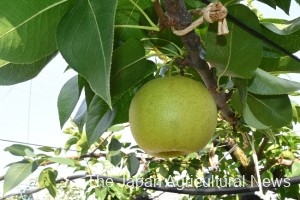TOKYO, Aug. 6 — The National Agriculture and Food Research Organization announced that it has developed Sogetsu, a new cultivar of Japanese pear with very early maturity.
The pear variety with yellow-green skin can be shipped to markets in the Kanto region before the Bon holidays in mid-August even in outdoor cultivation, meaning the pears can be marketed at high prices to meet the increase in demand for the fruit, as it is typically offered as gifts during that time.
Sogetsu can be cultivated in pear producing areas throughout the country. The saplings are expected to be put on sale in the autumn of 2026 or later.
The fruit weighs 367 grams, roughly the same as popular Japanese pear variety Kosui. It is large-sized for an extremely early maturing cultivar and tastes good, characterized by a peach-like milky aroma.
Sogetsu was selected from pears grown in 2007 by cross-breeding Natsushizuku, a Japanese pear variety with yellow-green skin, and Hatsumaru, a very early ripening cultivar with yellowish-brown skin.
It was named Sogetsu — meaning “blue moon” in Japanese — due to its beautiful yellow-green skin and round shape.
Pears are priced high between late July and mid-August, but there are few cultivars that can be harvested during the period.
Some pear growing regions adopt measures such as tunnel cultivation and gibberellin treatment to accelerate the growth of the fruit, but the burden of farming equipment costs and increased workload has been a challenge.
Compared with Kosui, Sogetsu’s flesh is slightly softer. Its sugar content and acidity are about the same as Kosui.
To cultivate Sogetsu in areas where poor germination of Kosui has been reported, it is necessary to take measures including changing the timing of fertilizer application.


